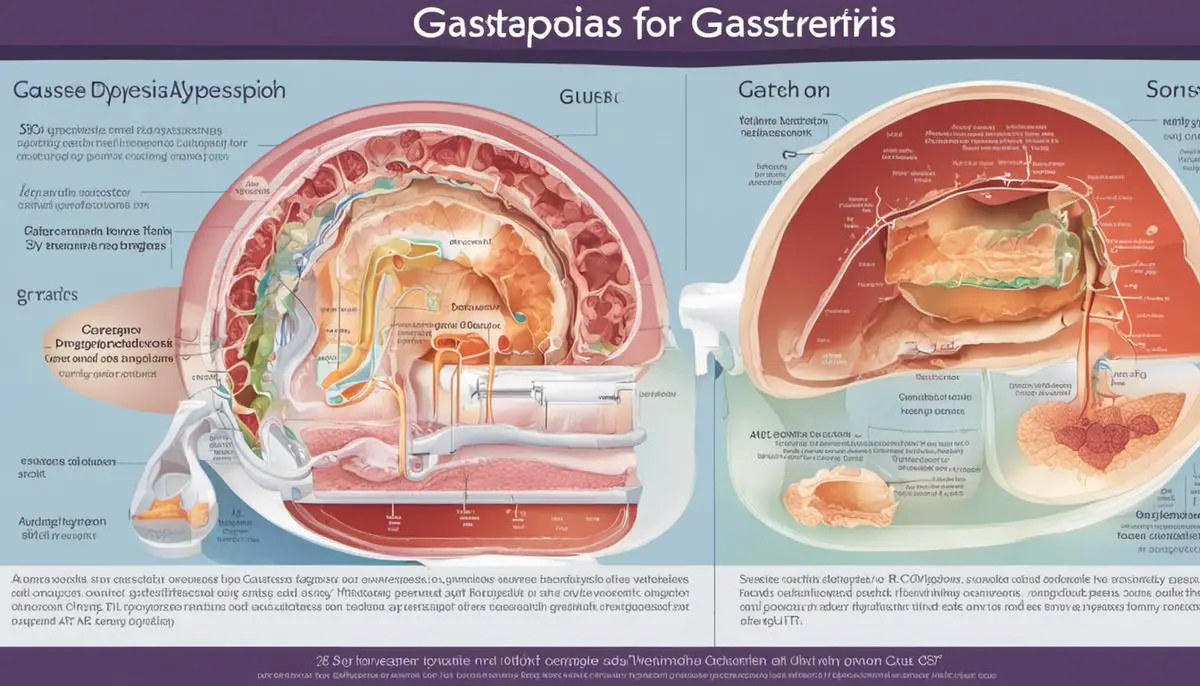Dyspepsia and Gastritis are medical conditions, both primarily involving digestive problems, that can greatly impact a person’s quality of life. Although these two conditions share many features, significant differences distinctively set them apart. The value in understanding conditions like these is undeniably critical, as this knowledge can significantly influence an individual’s approach towards their health and well-being. This exploration into the realm of Dyspepsia and Gastritis will transverse through various facets like their causes, symptoms, diagnostic procedures, and possible complications. Moreover, the emphasis will be placed on effective lifestyle changes that can massively contribute to managing these conditions, highlighting the significance of proactive participation in one’s health management journey.
Understanding Dyspepsia
Understanding Dyspepsia
Dyspepsia, more commonly known as indigestion, is a condition that involves a group of symptoms that lead to discomfort in the upper abdomen. It can sometimes be a sign of an underlying condition, such as gastritis, ulcers or gallbladder disease. Common symptoms include bloating, heartburn, nausea, and belching. It’s worth noting that dyspepsia is a symptom rather than a disease itself.
Causes of Dyspepsia
There are various known causes of dyspepsia. It could be triggered by acid reflux, gastritis, or stomach ulcers. Often, dyspepsia may result from a stomach or duodenal ulcer, gallstones, or an inflammation of the stomach lining (gastritis). Additionally, certain medications, like non-steroidal anti-inflammatory drugs (NSAIDs), antibiotics, and certain supplements can also lead to dyspepsia. Furthermore, lifestyle choices and habits such as overeating, consuming fatty or spicy foods, smoking, or consuming high amounts of caffeine or alcohol can contribute to dyspepsia.
Diagnosis and Complications from Dyspepsia
Diagnosis of dyspepsia usually involves an assessment of symptoms and medical history, along with tests including endoscopy, blood tests, and ultrasound. If left untreated, dyspepsia could potentially lead to complications such as gastroesophageal reflux disease (GERD), peptic ulcers, and, in rare cases, stomach cancer.
Dyspepsia Versus Gastritis
While both dyspepsia and gastritis cause discomfort in the stomach area, they are not the same. Dyspepsia is a set of symptoms, while gastritis is a condition in which the stomach lining is inflamed. Gastritis can cause the symptom of dyspepsia, but not everyone with dyspepsia has gastritis. Gastritis can sometimes be diagnosed through an endoscopy, which is not typically needed for diagnosing dyspepsia.
Lifestyle Changes to Manage Dyspepsia
Lifestyle modifications can help manage dyspepsia, lessening its impact on daily life. These can include dietary changes such as eating smaller, more frequent meals, avoiding food and beverages that trigger symptoms, and maintaining a healthy weight. Other lifestyle changes can include quitting smoking, reducing or eliminating alcohol intake, and exercising regularly. Furthermore, stress management techniques like yoga, meditation, and relaxation exercises can go a long way in managing dyspepsia symptoms.
Addressing Dyspepsia
If you’re dealing with dyspepsia, it’s essential to remember that treatment often involves addressing the root cause if it can be identified. Lifestyle modifications are often key, including changes to your diet. A variety of medications, encompassing proton pump inhibitors, H2 blockers, and antacids, can be administered to minimize stomach acid and alleviate discomfort. If an infection is the source of dyspepsia, antibiotics may be part of your treatment plan.

Understanding Gastritis
An Overview of Gastritis
Moving on to gastritis, it is important to know that this term encapsulates a variety of conditions all characterized by inflammation in the stomach lining. Various factors can spark this inflammation, such as prolonged use of specific medications like nonsteroidal anti-inflammatory drugs (NSAIDs), bacterial infections like Helicobacter pylori, chronic stress, overconsumption of alcohol, and persistent bile reflux.
Gastritis can present in two forms – acute and chronic. Acute gastritis occurs abruptly and comes with more intense symptoms, while chronic gastritis slowly progresses over time.
Symptoms of Gastritis
Common symptoms of gastritis include upper abdominal pain, nausea, and vomiting. In severe cases, you could have stomach bleeding, which might cause you to vomit blood, have blood in your stool, or anemia.
Diagnosis and Potential Complications
Gastritis is diagnosed through one or more tests. A doctor might recommend a blood test to detect the presence of H. pylori bacteria or anemia. Endoscopy allows a doctor to look at your stomach lining directly and, if necessary, perform a biopsy. Imaging tests such as X-rays or an ultrasound can also be useful.
If left untreated, chronic gastritis can result in serious complications such as stomach ulcers and atrophy of the stomach lining, and can increase the risk of stomach cancer.
Understanding Dyspepsia
Dyspepsia, often referred to as indigestion, is a term that describes discomfort or pain in the upper abdomen. It’s not a disease but rather a group of symptoms that can include bloating, nausea, belching, and a burning sensation in the stomach.
Like gastritis, dyspepsia may be caused by various factors like stress, consumption of spicy or fatty foods, overeating, excessive caffeine or alcohol consumption, and certain medications.
Dyspepsia versus Gastritis: Differentiating Symptoms and Causes
It is important to note that gastritis and dyspepsia are not the same thing but they have overlapping symptoms. The main distinguishing factor between these two is that gastritis is characterized by inflammation of the stomach lining while dyspepsia is a collection of symptoms indicating upper abdominal discomfort without visible organic cause.
Both conditions can be influenced by lifestyle factors such as diet and stress. While gastritis often requires more intensive treatment, both conditions can typically be managed and alleviated through dietary and lifestyle changes.
Approaches to Treatment
Gastritis and dyspepsia, or indigestion, share similar treatment methods due to their effects on the digestive system. Commonly, management of symptoms for these illnesses can be accomplished with over-the-counter antacids. However, severe cases might necessitate the use of antibiotics, proton pump inhibitors, or H2 blockers.
Alongside medicinal treatment, a change in lifestyle can have a significant impact on symptom management. Identifying and avoiding triggers such as spicy foods, drinks rich in alcohol, and high-stress environments can lead to a reduction in episodes of both dyspepsia and gastritis. Furthermore, maintaining regular exercise and observing a balanced diet can contribute to controlling the conditions.

Common and Unique Symptoms
Identifying Symptoms of Dyspepsia and Gastritis
Given that both dyspepsia and gastritis impact the digestive system, particularly the stomach, they are characterized by some overlapping symptoms. These common complaints can range from abdominal pain and bloating to loss of hunger and bouts of nausea.
Pain in the abdomen is particularly prevalent and can be described as a gnawing or burning sensation located in the upper stomach. Bloating, a state of feeling overly full or noticing a level of pressure in the stomach area, is another symptom present in both dyspepsia and gastritis. Due to the related discomfort in the stomach, loss of appetite may be noticed. Additionally, waves of nausea are also commonly experienced among those suffering from these conditions.
Unique Symptoms of Dyspepsia
While dyspepsia shares many symptoms with gastritis, there are certain symptoms that are more specific to this condition. For instance, dyspepsia often causes burping or belching, especially after meals. Excessive burping can often accompany the sensation of bloating and stomach discomfort.
Dyspepsia may also cause heartburn, which is a burning feeling in the chest or throat caused by stomach acid rising up into the oesophagus. This is a standout feature of dyspepsia that is usually not typical of gastritis. Some individuals with dyspepsia also report a sensation of hurried bowel movements or feeling like they need to pass stools more often.
Unique Symptoms of Gastritis
On the other hand, gastritis carries other symptoms that are not commonly found in cases of dyspepsia. These include vomiting, possibly with blood, and also the passing of tarry, black stools. This can occur when the inflammation in the stomach lining leads to bleeding, which then alters the color and consistency of the vomit and stools.
Another unique symptom of gastritis is a metallic taste in the mouth, caused by small amounts of leaked stomach acid. Chronically ill patients or those with acute gastritis might also experience weight loss over time due to reduced appetite or improper absorption of nutrients caused by the inflamed stomach lining.
Furthermore, since gastritis represents an inflammation of the stomach tissue itself, it can also cause pain that persists even when the stomach is empty – a symptom not often associated with dyspepsia.
Dyspepsia and gastritis, while sharing a multitude of common symptoms due to their gastrointestinal nature, possess unique characteristics allowing for specialized identification and treatment strategies. To correctly diagnose these conditions and monitor their progress, regular visits to a healthcare professional are of utmost importance.

Treatment and Prevention
Common Medicinal Approaches for Dyspepsia and Gastritis
Medication forms the primary line of treatment for both dyspepsia and gastritis. Dyspepsia treatments commonly include over-the-counter antacids and proton pump inhibitors such as omeprazole, aimed at minimizing the stomach acid’s volume. On the other hand, gastritis treatments encompass H2 receptor blockers and proton pump inhibitors. For gastritis resulting from a bacterial infection like Helicobacter pylori, antibiotics are usually prescribed.
Alternative Medicine for Dyspepsia and Gastritis
Alternative medicines also play a role in the treatment of these conditions. Probiotics, for example, are sometimes used to restore the balance of bacteria in the gut, which can help alleviate symptoms. For dyspepsia, herbal remedies such as peppermint, caraway seeds, and artichoke leaf might be recommended while for gastritis, some people find relief using slippery elm, licorice root, and chamomile.
Lifestyle Changes for Managing Dyspepsia and Gastritis
Beyond medicine, lifestyle changes are often pivotal in managing dyspepsia and gastritis. This could mean altering diet – avoiding spicy, fatty, or acidic foods, and lowering alcohol and caffeine intake. Regular exercise can also help, especially for dyspepsia, as it aids in digestion. Stress management is equally important as stress can exacerbate these conditions. This could include practices such as mindfulness, yoga, or other forms of relaxation.
Importance of Seeking Medical Help and Regular Checkups
Regardless of how one chooses to manage dyspepsia or gastritis, seeking medical help and regular checkups are crucial for prompt diagnosis and treatment. Both conditions, if left untreated, can lead to more serious issues such as peptic ulcers or even stomach cancer. Regular checkups are also important, as they allow medical professionals to monitor the condition and adjust treatment as necessary.
Preventive Measures for Dyspepsia and Gastritis
Preventive measures for dyspepsia and gastritis often coincide with the lifestyle changes used in managing them. This includes maintaining a healthy diet low in acidic and spicy foods, practicing regular exercise, and managing stress. Avoiding smoking and excessive alcohol intake can also help prevent these conditions. In addition, washing hands and food properly can prevent infection that might contribute to gastritis.

By delving through the intricacies of Dyspepsia and Gastritis, we’ve provided a roadmap that singles out the key differences and similarities of these conditions. The real metaphor of this exploration extends beyond these conditions, encouraging readers to take charge of their health. Condition-specific symptoms along with the respective treatment options have been discussed, addressing their unique nature and aiding individuals in making informed decisions. Proactive lifestyle changes could potentially make significant strides in managing such conditions. Above all, remember that regular medical check-ups and early diagnosis will always be the first and foremost line of defense against any medical adversities you might encounter. Diseases understood are half cured, and information empowers us to keep our health in check and live a fulfilled life.
